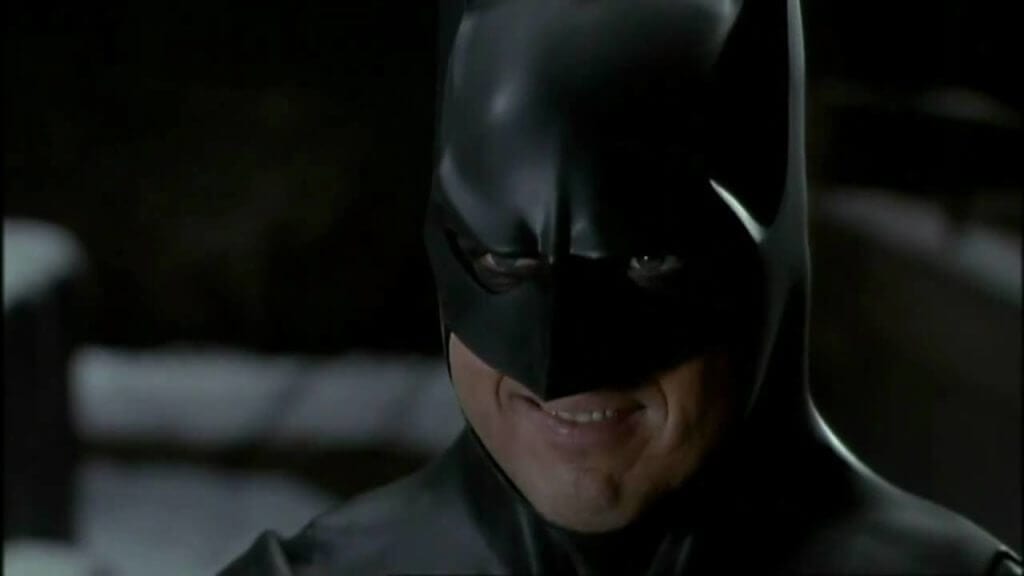Whatever Gotham Needs Him to Be
Batman, like most comic characters, has gone through many different phases and versions over his seventy-seven-year history, from dark avenger to silly goofball to a sort of swashbuckling adventurer, with many different shades mixed in. His cinematic exploits have followed suit, portraying him alternately as a creature of the night and a campy punster. While it’s difficult to say any version is the “one true Batman,” we all have our favorites and we’ll defend them to the death, such is the level of passion this character brings out in his fans.
When it comes to the movies, my two favorites are the versions found in Tim Burton’s and Christopher Nolan’s movies, played by Michael Keaton and Christian Bale. (I know, way to be controversial.) At first glance, they may seem similar to each other, with their embracing of darkness and tortured depictions of Bruce Wayne; in truth, they’re quite different, but they also complement each other and showcase different classical aspects of Batman.
*Spoilers for all of the Burton and Nolan Batman films*

Michael Keaton – Batman (1989), Batman Returns (1992)
“Now you wanna get nuts? Come on! Let’s get nuts!”
Bluntly, Keaton’s Batman is a psychopath. In both films, Tim Burton’s focus is on the madness at play in a man who dresses up like a bat to fight crime. He’s a violent, antisocial recluse who’s only alive when he puts on the costume; his introductory scene in Batman Returns has him sitting alone in the dark, brooding silently until the Bat Signal shines in the sky and finally he animates, ready to go into action once again. In fact, Burton and Keaton make the case that Bruce Wayne is the mask he wears and Batman is the true identity. And it’s a mask he wears poorly; Keaton’s Wayne is often accused of being a bit ill-defined, but that’s because he’s meant to be a cipher, something no one can fully understand because Bruce himself doesn’t understand that persona. We never really see him run Wayne Enterprises because he has no interest in it. He sleeps hanging upside down like a bat because he yearns to be in his real home, in a dark cave plotting his next attack on crime. When he’s forced into social situations, he acts like a weirdo because he really doesn’t want to be social.
For example, when he first meets Vicki Vale, he pretends he’s not Bruce Wayne; that’s a strange thing to do, and he does it because he’s uncomfortable being Bruce Wayne. He’s attracted to Vicky, but instead of using any kind of charm to try to woo her, he does creepy things like follow her around as she tours his mansion. (Luckily for him, his oddness fascinates her.) This is not a good cover for someone trying to convince the world he couldn’t be the nut job who runs around in a costume at night, but it’s the best Bruce can do, and even this minimal effort is a strain for him. Even when he decides to reveal himself to Vicki he struggles to make her understand his mindset with that out-of-left field analogy about a guy who kisses his wife and eats breakfast. He has no idea how to open up to someone, and it takes Alfred forcing the issue by showing Vicki the Batcave to finally get him to have a normal, honest conversation with her; Alfred has pulled off Bruce’s mask for him, showing Vicki the real man underneath, because he knows that’s the only way Bruce and Vicki will have a prayer of making it work.
Ultimately, of course, it doesn’t, because despite Vicki accepting him as Batman, she can never truly understand him. Selina Kyle, on the other hand, gets why Bruce has to be Batman because she has to be Catwoman. They recognize their own reflection in each other, the image of a person whose skin is a mask for the true self that only comes out at night in a leather outfit. Their lovers’ embrace on Bruce’s couch highlights their fear at letting someone see past their masks (each tries to hide their scars from the other, despite not knowing they are Batman and Catwoman), but they cannot deny their intense attraction; it’s noteworthy that this directly follows a discussion of why Bruce and Vicki couldn’t last. When they finally find out about each other, Bruce sees Selina as his chance to leave Batman behind and have a normal life as Bruce Wayne, with a Catwomanless Selina Kyle by his side. Selina understands that this is hopeless; they would never be happy as a traditional couple. They’re only at home in the shadows, spreading violence and indulging their desires, and there’s no happy ending for people like them. Bruce Wayne can only be Batman.
In addition to Selina, Bruce/Batman’s psychosis is reflected in his villains. The Joker begins life as Jack Napier, a gangster who probably should be running the organized crime in Gotham City, but he’s stuck as Boss Carl Grissom’s lieutenant. He is, in every respect, a man repressed; he takes orders from “an old man,” he isn’t respected by the bad cops on his outfit’s payroll, he gets sent on jobs that are beneath him (despite Grissom having an ulterior motive for putting him in charge of the Axis Chemicals robbery, you get the impression Jack gets the short end of the stick pretty often), he has to sneak around with the girl he wants because she belongs to a lesser man. Yet, through it all, Jack believes in his own greatness; he adores himself in the mirror, he threatens the District Attorney, he carries on an affair with the girl who is denied him and he strong-arms the crooked cop while insisting he will one day take what’s his. But still, he’s forced into the role society (even if it is the criminal fringe of society) demands he hold, just like Bruce when he’s not Batman; when Jack holds his Joker playing card, it’s like his longing for the freedom to be who he was meant to be.

That gift is afforded to him by Batman via a bath in toxic chemicals. When he emerges as the Joker, it sets him free, as being Batman sets Bruce free. He kills Grissom and takes over the Gotham underworld, murdering anyone else who stands in his way and outfitting his henchmen in jackets that bear his image. He causes absolute chaos and destruction, no longer beholden to the profit motive or people who refuse to dream big. He makes the woman he desires a deformed monster like himself, then kills her when he decides he’s no longer interested. (He claims she killed herself, but his smashing the mask when he says so, combined with his lustful pursuit of Vicki, indicates that the Joker was the one who shoved her out that window.) As Batman is Bruce Wayne’s true identity, so is the Joker Jack Napier’s. He and Batman go to war with each other, oblivious to the fact that they’re more alike than either one of them would care to admit – though when Vicki says that some believe Batman is as crazy as the Joker, Bruce’s silent glare suggests a part of him knows that to be true. And, finally, the two of them create each other, Joker by killing Bruce’s parents many years ago, Batman by dropping Jack into the chemicals. The two arch-nemeses, opposite sides of the same coin, are responsible for letting each other free to be who they really are.
The Penguin is another mirror for Batman in that his origin is incredibly similar, only with a dark twist: while Bruce has his parents taken from him, Oswald Cobblepot is cast out, an unwanted deformity denied the life he deserved by those who were supposed to love him. He and Bruce both hate the world for its cruelty, but while Bruce’s tragedy pushes him to protect the innocent, Penguin’s motives are selfish; Penguin becomes the aggressor instead of the protector, forcing the innocent to feel his pain and, upon being goaded by Max Shreck, taking the privilege and esteem that had been stolen from him by his parents. Underneath it all, though, is the mania of the criminally insane, and this is why Bruce is initially the only one who can see through Penguin’s façade; it takes a psychopath to spot a psychopath, and Bruce sees quite a bit of his own demons in Oswald Cobbelpot’s eyes. It’s very much a “There but for the grace of God go I” theme, as Batman and the Penguin, while sharing a tragic background, use it as motivation for different ends. This is best encapsulated when Penguin kidnaps all the firstborn sons of Gotham with the intent of drowning them, only for Batman to rescue them; Oswald wants the children to share his misery while Bruce wants to spare them from his own.
Because his fragile mental state is such a major element to Burton’s films, I don’t have an issue with this Batman killing. I completely understand people who are opposed to it, but I think Burton and Keaton do the necessary work to make that a logical action taken by this version of the character. They never shy away from the fact that Batman is nuts, and that if things were just a little different he could be the Joker or the Penguin, so it follows that, when he lets loose as Batman, when he’s finally embracing his true self, he would take his violence so far that he would end lives without a second thought. In Batman Returns, he even smiles wickedly when he ties the bomb to the strongman and lets him explode, reveling in the murderous aspects of his crime-fighting. When he tries to convince Selina not to kill Shrek, she knows to spare his life would be a betrayal of who she is and of who Bruce is, and it’s the biggest indication that they could never have a happy life together. The death isn’t there just to be cool or edgy; it has a purpose, rooted in character, and that’s what makes it work.
This is why Michael Keaton was the perfect choice to play Burton’s Batman. He has a madness in his eyes that comes through both in and out of the costume, and those incredible arching eyebrows that reveal the darkness within. He gives the impression of being a man possessed by something he’s barely controlling, and woe be unto the forces of evil who dare to menace Gotham. Bale’s films may bare this moniker, but Keaton’s Batman really is the Dark Knight.

Christian Bale – Batman Begins (2005), The Dark Knight (2008), The Dark Knight Rises (2012)
“I want to show the people of Gotham their city doesn’t belong to the criminals and the corrupt.”
So, if Michael Keaton is the real Dark Knight, what does that make Christian Bale? As I see it, the Caped Crusader. Nolan’s films are less concerned with the psychological reasons for Bruce Wayne’s war on crime and more interested in framing it as a noble quest by a guy who wants to continue his father’s work and save his city. This Bruce isn’t obsessed with the darkness inherent in humanity, but driven to bring out the good in it. He is, however, a realist who understands that the deck is stacked in favor of evil, so he becomes Batman as an inspirational symbol. He’s giving people hope when he takes down the powerful gangsters that run Gotham, and showing them what Gotham can be if they all choose to be better than their surroundings.
In Batman Begins, the various figures in his life all help him shape his philosophy. His parents’ murder makes him experience firsthand the pain of loss from crime. Through Rachel Dawes, he learns about how the untouchable mob bosses are keeping Gotham in poverty, hooking them on drugs and forcing them to turn to crime for survival, and that the pain he feels is suffered by many others every day; essentially, he learns empathy from her. Alfred reminds him of the noble legacy his father has left for him, how a man who had so much endeavored to give back all he could (something Rachel tries to do too, but in a cold, insulting way that makes me question how much of a friend she ever considered him; cards on the table, I love these movies but I hate this character). Carmine Falcone, the representation of the corruption that plagues Gotham and killed Bruce’s parents, teaches him about the power of fear and where that fear comes from. Finally, Ra’s al Ghul teaches him how to conquer his fears and use them to make himself stronger (and, of course, how to fight).
The result of all this is Batman. Bale’s Batman fights for the weak and defenseless, just like his father. He works around the corruption that prevents criminals from going to prison. He fights the people the law is too afraid to fight, and he makes them afraid of him. Most of all, though, he shows people that Gotham can be better. The clearest example is Gordon, who begins the movie as a disillusioned “one good cop in a bad town,” but he’s so weary from the toxic world surrounding him that he’s just learned to accept it. (“I’m no rat! In a town this bad, who is there to rat to?”) Once Batman enlists his help, he starts to see that there is a way to save the city he’d given up on, if only he finds the will to act. This is why it’s crucial that he’s so involved in the climax, and that he’s using one of Batman’s tools himself; he is firmly a part of the solution now, fully embracing Batman’s tactics.
Ra’s al Ghul emphasizes Batman’s sincere belief in the redemption of Gotham because he believes the opposite: Gotham is too far gone to be saved and must be destroyed. He isn’t a criminal so much as he is an extreme form of justice; he is justice without compassion, while Rachel is justice without the will to be effective. Batman is the perfect merging of the two, doing things the police and district attorneys can’t, but always with the goal of saving as opposed to annihilating. His mission in the final battle of Batman Begins isn’t to defeat evil, but to reshape justice – both Rachel’s and Ra’s al Ghul’s – and to allow good the chance to rise.

The Dark Knight is where evil truly pushes back. Bruce and his confederates have all but eliminated organized crime and rooted out much of the corruption, but in doing so have opened Pandora’s Box and allowed an even greater evil to emerge. Unlike Ra’s al Ghul, who wanted merely to destroy Gotham, the Joker wants to rule it like the devil of his own personal hell, turning the good people of Gotham into his demons through sheer madness. He is diametrically opposed to Batman’s philosophy, in that he believes in the inherent evil in mankind and wants to bring it out, rather than the good. Where Batman gave hope, the Joker is taking it away, and he’s so good at it he even pushes Bruce to his breaking point, causing him to question his entire crusade (from “Batman has no limits” to “I was meant to inspire good, not madness, not death”). In the end, though, the Joker is defeated through Batman’s optimism; when everyone else – even Gordon, the man he most convinced to hope for a better world once again – has lost faith in mankind’s better nature, Batman clings to it, insisting that the hostages on the boats won’t blow each other up, even in the face of certain death.
And he’s right! Well, barely, but in the end the citizens and prisoners do the right thing, choosing death over becoming monsters. The result highlights the symbiotic relationship between Bale’s Batman and Gotham itself: Gotham needs Batman to save it, and Batman needs to know that Gotham is worth saving. Thanks to the Joker, they’re both suffering from a crisis of faith, and in their darkest moment, they choose to trust in good. That trust is rewarded; Batman trusts that the hostages won’t resort to murder and they reward him by not doing it, while the hostages trust that they don’t have to lose their souls in order to survive and Batman rewards them by stopping the Joker from killing them. (“What were you trying to prove? That deep down, everyone’s as ugly as you?”)
But, as the Joker tells Batman, “You need an ace in the hole; mine’s Harvey.” Harvey Dent is the character who most singularly personifies Gotham itself, caught between Batman’s hope and the Joker’s despair. He is the “white knight,” the upstanding savior who can free Gotham from evil, and unlike Rachel, he understands that someone like Batman is necessary to bring about the change Gotham needs. He speaks admiringly of Batman during the dinner scene, and when Bruce later announces “I believe in Harvey Dent,” he’s declaring Harvey as the representation of what he sees as the good in humanity. But Harvey has a dark side too, and we see it come out here and there over the course of the film, most notably when he threatens to shoot the Joker’s henchman. Batman keeps him in check, but the capacity for evil is established, and Harvey is susceptible to fear, pain and a loss of hope, just like the rest of Gotham. When he is scarred and he loses Rachel, he gives in to that evil and becomes Two-Face, showing Batman how fleeting hope can be, and how much work it takes to maintain it.
That work is shown in The Dark Knight Rises, and it’s not what we initially thought (or at least not what I did); instead of having to remain Batman, Bruce has had to shelve him, going into a self-imposed exile and allowing Batman to be vilified so that the city could find its hope in another. The problem is, in doing so, he wasn’t putting his faith in the people; he chose not to trust them, and that is what gives Bane the ability to seize power. Bane takes over Gotham, but initially the people are not on his side; they’re just scared of him. He isn’t able to truly win them over until he reveals that they were lied to by those they trusted to protect them. When Batman took the blame for Two-Face’s murders, he reneged on the tacit agreement established at the end of The Dark Knight: they trust him, he trusts them. Bruce didn’t trust Gotham, and now they’re putting their trust in the guy who’s being honest with them, despite the fact that he’s a monster. Now Batman is a true pariah and Gotham is closer than ever to being destroyed, not by a fear toxin or their own psychological breakdown, but by a nuclear weapon that will just vaporize them.

Bruce’s quest in this movie is to regain their trust, and to do that he has to earn the right to be Batman again. In the beginning, he uses gadgets to make himself physically able, but like his acceptance of the blame for Harvey’s crimes, they’re artificial and don’t stand up to the force of his new enemy. Bane breaks him physically the way he broke himself in the eyes of Gotham, and it takes work to repair both. When he escapes the prison, he does it by training, by stripping himself of every false trapping, even the rope that will save his life. He trusts himself, and he’s able to conquer that which conquered all others (except Talia).
When Bruce returns, he seeks the help of the people by inspiring them and trusting them to fight with him. When his army meets Bane’s, the two tanks stand ready to gun them down, but they once more trust Batman by running into the fray, and Batman once again earns their trust by disabling the tanks and allowing them to meet Bane’s soldiers in combat. Catwoman represents this idea too; she let him down by betraying him to Bane out of fear (“…you should be as afraid of him as I am”), but Batman chooses to trust her with opening the tunnel. She rewards that trust by coming through for him, both in opening the tunnel and in shooting Bane before he can kill Batman. And finally, Batman makes the ultimate sacrifice in “killing” himself to save them, destroying Batman figuratively so that all of Gotham (and John Blake in particular) can take up his mantle. In Batman Begins he set out to save Gotham, and in The Dark Knight Rises he finally does it.
Once more, the perfect actor was chosen for this iteration of Batman. Christian Bale has proven how great he is over and over, and it would’ve been easy after American Psycho for him to play Batman as a nut in the Keaton vein, but he and Nolan went a different way and presented a Batman who lurks in darkness out of necessity but strives for the light. (It’s not an accident that his final moment, not to mention his final battle, occur in broad daylight.) Bale doesn’t need to be Batman like Keaton did; Rachel says he does in The Dark Knight, but she’s wrong (as she pretty much always is). Catwoman, once again, is the one who really gets that Batman isn’t what he wants to be, but what he needs to be (“Once you do what you have to, they’ll never let you do what you want to”) and, as a result, she is with him when he is finally free, his crusade over. His determination in the face of overwhelming odds, his refusal to let himself be defeated, is one of the most quintessential aspects of the character – perhaps the most important reason he has endured for so many years – and Bale captures that expertly. His is a Batman to believe in.
***
Batman’s cinematic road has certainly been a rocky one, but whatever missteps there have been or will be in the future, we can count ourselves fortunate to have gotten two such fascinating versions of one of pop culture’s most beloved figures. Michael Keaton and Christian Bale, as well as Tim Burton and Christopher Nolan, have cemented themselves in the Dark Knight’s history books as crafting two of the gutsier interpretations of Bruce Wayne. While his immediate future is pretty much set, this is a character that will no doubt be reborn on screen again and again throughout the ages, and sooner or later someone will build a Batman that can confidently stand alongside these two. One can hope, anyway.







